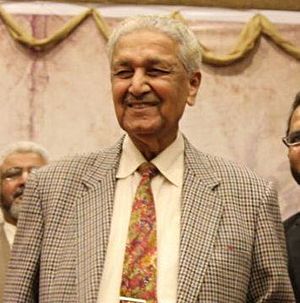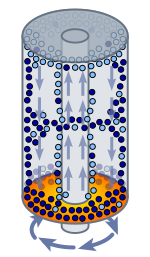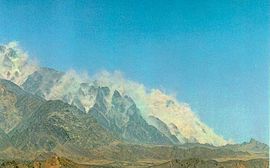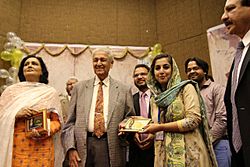Abdul Qadeer Khan facts for kids
Quick facts for kids
Abdul Qadeer Khan
NI HI FPAS
|
|
|---|---|

Khan in 2017
|
|
| Born | 1 April 1936 |
| Died | 10 October 2021 (aged 85) Islamabad, Pakistan
|
| Nationality | Pakistani |
| Alma mater | University of Karachi Delft University of Technology Catholic University of Louvain D. J. Sindh Government Science College |
| Known for | Pakistan's nuclear weapons program, gaseous diffusion, martensite and graphene morphology |
| Spouse(s) |
Hendrina Reternik
(m. 1963) |
| Children | 2 |
| Awards | |
| Scientific career | |
| Fields | Metallurgical engineering |
| Institutions | Khan Research Laboratories GIK Institute of Technology Hamdard University Urenco Group |
| Thesis | The effect of morphology on the strength of copper-based martensites (1972) |
| Doctoral advisor | Martin J. Brabers |
| Science Advisor to the Presidential Secretariat | |
| In office 1 January 2001 – 31 January 2004 |
|
| President | Pervez Musharraf |
| Preceded by | Ishfaq Ahmad |
| Succeeded by | Atta-ur-Rahman |
| Personal details | |
| Political party | Tehreek-e-Tahaffuz-e-Pakistan (2012–2013) |
Abdul Qadeer Khan, often called A. Q. Khan, was a Pakistani nuclear physicist and engineer. He is widely known as the "father of Pakistan's atomic weapons program". He was also called Mohsin-e-Pakistan, meaning "Protector of Pakistan".
Born in India, Khan moved to Pakistan in 1952. He studied metallurgical engineering in Europe. There, he focused on how metals change and how to separate uranium isotopes using gas centrifuges. After India's nuclear test in 1974, Khan joined Pakistan's efforts to develop atomic weapons. He started the Khan Research Laboratories (KRL) in 1976 and was its main scientist and director for many years.
In 2004, Khan faced questions from the government about sharing nuclear technology. He was accused of sharing nuclear information and was placed under house arrest. He later said these accusations were not true. In 2009, a court ruled that his house arrest was against the law, and he was freed. Some countries, like the United States, were concerned about the information he had.
Abdul Qadeer Khan passed away on October 10, 2021. He received a state funeral in Islamabad.
Contents
Early Life and Education
Abdul Qadeer Khan was born on April 1, 1936, in Bhopal, a city in what was then British India. His family moved to Pakistan in 1952. This move was partly because of religious violence in India and other issues at the time.
He settled in Karachi with his family. Khan first went to D. J. Science College. Then, he transferred to the University of Karachi. In 1956, he earned a degree in physics.
From 1956 to 1959, Khan worked for the Karachi Metropolitan Corporation. He then received a scholarship to study in West Germany. In 1961, he went to the Technical University Berlin to study material science. He did very well in metallurgy courses. In 1965, he moved to the Delft University of Technology in the Netherlands.
In 1962, he met Hendrina "Henny" Reternik. She was born in South Africa but had British and Dutch roots. They got married in 1963 at Pakistan's embassy in The Hague. Khan and Henny had two daughters, Dina and Ayesha.
In 1967, Khan earned an engineer's degree in materials technology. This is similar to a Master of Science degree. He then joined a program for his doctorate in metallurgical engineering. He studied at the Katholieke Universiteit Leuven in Belgium. In 1972, he earned his doctorate degree. His research focused on martensite, a type of metal structure.
Career in Europe
In 1972, Khan started working at Physics Dynamics Research Laboratory (FDO) in Amsterdam. This company was a partner of URENCO. URENCO is a group that enriches uranium. They used a method called gaseous centrifuge to make nuclear fuel for power plants. Khan later joined URENCO in a senior technical role. He studied uranium metallurgy.
Uranium enrichment is a complex process. Natural uranium has only a small amount of uranium-235 (U235). This is the part needed for nuclear reactions. URENCO used special centrifuges to separate U235 from other types of uranium. These machines spun uranium gas very fast, up to 100,000 times per minute. By 1973–74, Khan focused on making these centrifuges work better.
Khan was later accused of taking designs of centrifuges from URENCO. In 1975, URENCO became suspicious, and Khan moved to a less sensitive role. He soon returned to Pakistan with his family. In 1983, the Netherlands sentenced him to prison for sharing information, but the decision was later overturned.
Scientific Career in Pakistan
Starting Pakistan's Nuclear Program
In May 1974, India conducted a nuclear test called 'Smiling Buddha'. After this, Abdul Qadeer Khan wanted to help Pakistan develop its own atomic bomb. He wrote to Pakistan's Prime Minister, Zulfikar Ali Bhutto.
At that time, Pakistani scientists were already working on a secret nuclear program. This program was led by Munir Ahmad Khan, a reactor physicist. Prime Minister Bhutto met with Abdul Qadeer Khan in December 1974. Khan explained how important highly enriched uranium was for making a bomb.
The next day, Khan met with Munir Ahmad and other scientists. He pushed for using highly enriched uranium instead of plutonium. He believed plutonium would not work as well. Officials advised Khan to stay in the Netherlands. They wanted him to learn more about centrifuge technology. He was to keep helping Pakistan's enrichment program. By December 1975, Khan felt unsafe and decided to return home.
Khan Research Laboratories and the Atomic Bomb
In April 1976, Khan officially joined Pakistan's atomic bomb program. He worked on the enrichment division. Khan believed that weapon-grade uranium was the best path. He felt frustrated because his ideas were not a top priority. Most efforts were focused on producing military-grade plutonium.
Khan became unhappy with the research being done. He wrote a report to Prime Minister Bhutto. In it, he said the enrichment program was not succeeding. Bhutto saw the problem and asked Khan to lead the enrichment division. Khan then started the Engineering Research Laboratories (ERL). This lab worked directly under the Army. The army engineers found a site in Kahuta for the enrichment program. This isolated location was ideal for safety.
Another program was also running to separate isotopes. This was led by Ghulam Dastagir Alam at the Air Research Laboratories (ARL). Alam had little knowledge of centrifuges but achieved a great feat. He perfectly balanced the first centrifuges to spin at 30,000 revolutions per minute. He then helped Khan at ERL. Together, Khan and Alam made the first centrifuges work. They successfully separated the uranium isotopes.
Khan's scientific skills were well-known in the military. He was often called "Centrifuge Khan." In 1983, the national laboratory was renamed Khan Research Laboratories (KRL) after him. However, Khan was not in charge of designing the actual nuclear devices. That work was led by Munir Ahmad Khan and the PAEC.
Some scientists who worked with Khan felt he exaggerated his achievements. Munir Khan once said that most scientists on the bomb project were "serious." He added that Abdul Qadeer Khan was more of a "showman." Khan often published papers on the science of centrifuges. He tried to compete with other physicists but often failed to impress them. He also often criticized Munir Khan's work. Their scientific rivalry became well-known.
Nuclear Tests: Chagai-I
Many scientists were unsure if military-grade uranium could be ready in time. This was because the centrifuge designs were incomplete. Khan had brought designs from URENCO. However, these designs had technical errors. The centrifuges also spun too slowly. This made them very expensive to operate.
Khan's knowledge of copper metallurgy helped improve the centrifuges. But it was his team, including mathematician Tasneem Shah and G. D. Alam, who solved the complex math problems. These solutions helped Khan create better centrifuge designs. Scientists have said that Khan would not have succeeded without their help.
Khan also strongly supported using a simpler 'gun-type' nuclear device. This type of device uses highly enriched uranium. He was against the more complex 'implosion-type' devices that used plutonium.
In 1998, India conducted new nuclear tests called 'Pokhran-II'. After this, Pakistan decided to conduct its own tests. Khan was not chosen to lead this project. This was likely due to his strong personality. However, he was allowed to be a witness to Pakistan's first nuclear test, 'Chagai-I', in May 1998. At a news conference, Khan confirmed that KRL's highly enriched uranium was used in the tests.
Some of Khan's colleagues were annoyed that he took full credit. He later wrote an article, "Torch-Bearers," to show that he was not alone. Khan also tried to work on the Teller–Ulam design for a hydrogen bomb. But military leaders did not agree with this idea.
Government Work and Academia
Khan's ideas about sharing nuclear technology were not popular with all scientists. But he was well-liked in political and military circles. After leaving KRL in 2001, Khan became a science and technology advisor to President Musharraf. He pushed for more spending on Pakistan's missile program. He also suggested using the Ghauri missile to launch satellites into space.
In 2007, Prime Minister Shaukat Aziz praised Khan on state television. He said Khan's services to the country were "unforgettable."
In the 1990s, Khan became a fellow of the Pakistan Academy of Sciences. He was its president from 1996–97. Khan wrote two books on material science. He also published articles from KRL starting in the 1980s. He served as a project director at the Ghulam Ishaq Khan Institute of Engineering Sciences and Technology. He also taught physics there. Later, he joined the faculty of Hamdard University. He remained on its board until his death. Khan also helped create the A. Q. Khan Institute of Biotechnology and Genetic Engineering at Karachi University.
In 2012, Khan announced a political group called Tehreek-e-Tahaffuz-e-Pakistan. This group was later dissolved in 2013.
Illness and Death
In August 2021, Abdul Qadeer Khan tested positive for COVID-19. He was admitted to Khan Research Laboratories Hospital. He passed away on October 10, 2021, at age 85. He died after being moved to a hospital in Islamabad with lung problems. He received a state funeral at the Faisal Mosque and was buried in Islamabad.
Pakistan's Prime Minister, Imran Khan, and President Arif Alvi expressed their sadness. They both called him a national icon and said the nation would never forget his services.
Legacy
During his work on the atomic bomb project, Khan did important research in physics. He also wrote articles about chemical reactions. He believed in using technology, including military technology, to help people. Khan strongly supported Pakistan's nuclear testing program. He felt nuclear weapons would protect his country.
Khan faced criticism from other scientists. Some, like Pervez Hoodbhoy, questioned his understanding of physics. Khan also claimed he was the "father" of the atomic bomb project from the start. This, along with his personal attacks on Munir Ahmad Khan, caused tension with other physicists.
Despite some disagreements and his strong personality, Khan remained a popular public figure. Many people in Pakistan see him as a national hero. He received many medals and honors from the government and universities. Khan is the only Pakistani citizen to have received the Nishan-e-Imtiaz twice.
|
|
See Also
 In Spanish: Abdul Qadir Khan para niños
In Spanish: Abdul Qadir Khan para niños
- Dr. A. Q. Khan Institute of Computer Sciences and Information Technology
- Dr. A. Q. Khan Research Laboratories
- Pakistani missile research and development program
- Conservatism in Pakistan
- Nuclear espionage
- Nuclear arms race
- Nuclear Secrets, 2007 documentary series about the nuclear race and proliferation including Khan's role therein
- Anwar Ali (physicist), Pakistani physicist charged with nuclear proliferation
- Peter Finke, German physicist in the nuclear weapons programme of Pakistan




